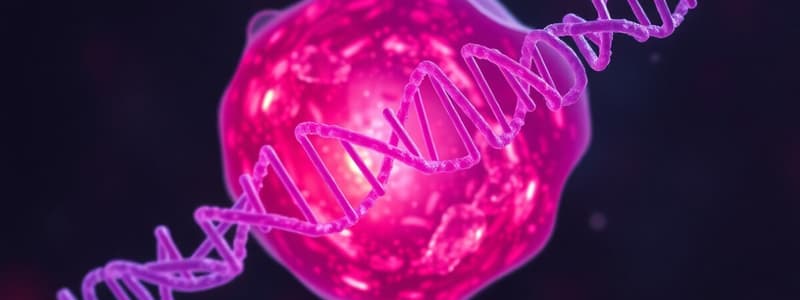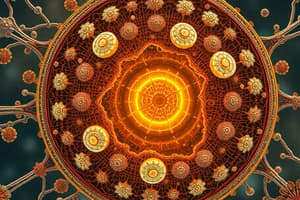Podcast
Questions and Answers
Which cellular component is characterized by a double-walled structure and occasional connections to the endoplasmic reticulum?
Which cellular component is characterized by a double-walled structure and occasional connections to the endoplasmic reticulum?
- Nuclear membrane (correct)
- Endoplasmic reticulum
- Ribosome
- Nucleolus
A researcher observes a high concentration of RNA within a distinct structure inside the nucleus. Which specific structure is the researcher most likely observing?
A researcher observes a high concentration of RNA within a distinct structure inside the nucleus. Which specific structure is the researcher most likely observing?
- Endoplasmic reticulum
- Chromatin
- Nuclear membrane
- Nucleolus (correct)
What is the main role of the nucleolus within the cell nucleus?
What is the main role of the nucleolus within the cell nucleus?
- Protein synthesis
- DNA replication
- Ribosome assembly (correct)
- Lipid metabolism
Apart from RNA, what other primary components are found within the nucleus?
Apart from RNA, what other primary components are found within the nucleus?
If connections between the nuclear membrane and the endoplasmic reticulum were disrupted, what immediate functional consequence would be expected?
If connections between the nuclear membrane and the endoplasmic reticulum were disrupted, what immediate functional consequence would be expected?
How many chromosomes are present in a typical human somatic cell, and what is the source of these chromosomes?
How many chromosomes are present in a typical human somatic cell, and what is the source of these chromosomes?
Which of the following best describes the composition of a chromosome?
Which of the following best describes the composition of a chromosome?
What is the term used to describe the complete set of genetic information within a cell or organism?
What is the term used to describe the complete set of genetic information within a cell or organism?
Which of the following structures found in the cytoplasm are enclosed by membranes?
Which of the following structures found in the cytoplasm are enclosed by membranes?
A researcher is studying a cell and observes a high level of protein synthesis. Which cytoplasmic structure would likely be most abundant in this cell?
A researcher is studying a cell and observes a high level of protein synthesis. Which cytoplasmic structure would likely be most abundant in this cell?
Which factor, when increased, would likely result in decreased radiosensitivity of a tissue?
Which factor, when increased, would likely result in decreased radiosensitivity of a tissue?
Why are tissues with high metabolic activity more susceptible to radiation damage?
Why are tissues with high metabolic activity more susceptible to radiation damage?
Consider two tissues, one with a high proliferation rate and another with a low proliferation rate. If both tissues receive the same dose of radiation, what is the likely outcome?
Consider two tissues, one with a high proliferation rate and another with a low proliferation rate. If both tissues receive the same dose of radiation, what is the likely outcome?
What is a common characteristic among tissues that exhibit high radiosensitivity?
What is a common characteristic among tissues that exhibit high radiosensitivity?
How does the age of tissue influence its radiosensitivity following exposure to ionizing radiation?
How does the age of tissue influence its radiosensitivity following exposure to ionizing radiation?
In the context of cellular radiation sensitivity, why is it important to protect the nucleus during radiation therapy?
In the context of cellular radiation sensitivity, why is it important to protect the nucleus during radiation therapy?
If a scientist aims to study the primary site of radiation-induced damage in a cell, which cellular component should they focus on?
If a scientist aims to study the primary site of radiation-induced damage in a cell, which cellular component should they focus on?
How does the specific function of a cell relate to the overall health and functioning of the human body?
How does the specific function of a cell relate to the overall health and functioning of the human body?
How does high LET (Linear Energy Transfer) radiation affect the probability of interaction with a target molecule?
How does high LET (Linear Energy Transfer) radiation affect the probability of interaction with a target molecule?
Imagine a scenario where the nucleus of a cell has been exposed to a high dose of radiation. Considering the function of the nucleus, what is the mostly likely outcome?
Imagine a scenario where the nucleus of a cell has been exposed to a high dose of radiation. Considering the function of the nucleus, what is the mostly likely outcome?
What strategy can be employed to minimize damage to healthy cells during radiation therapy?
What strategy can be employed to minimize damage to healthy cells during radiation therapy?
What type of radiation is conventionally used as the standard for determining relative biological effectiveness (RBE)?
What type of radiation is conventionally used as the standard for determining relative biological effectiveness (RBE)?
If a type of radiation has a high RBE, what does this indicate about its biological effectiveness compared to standard radiation?
If a type of radiation has a high RBE, what does this indicate about its biological effectiveness compared to standard radiation?
What is the relationship between LET and the occurrence of ionizations?
What is the relationship between LET and the occurrence of ionizations?
Why is the frequency of ionizations important in the context of radiation interaction with a target molecule?
Why is the frequency of ionizations important in the context of radiation interaction with a target molecule?
How does radiosensitivity change throughout the human lifespan?
How does radiosensitivity change throughout the human lifespan?
If two individuals, one a fetus and the other a mature adult, are exposed to the same dose of radiation, who will likely experience more severe effects?
If two individuals, one a fetus and the other a mature adult, are exposed to the same dose of radiation, who will likely experience more severe effects?
At what stage of life are humans generally least vulnerable to radiation effects?
At what stage of life are humans generally least vulnerable to radiation effects?
A pregnant woman is inadvertently exposed to a low level of radiation. Based on the information about radiosensitivity, what is the greatest concern?
A pregnant woman is inadvertently exposed to a low level of radiation. Based on the information about radiosensitivity, what is the greatest concern?
Considering the age-related radiosensitivity in humans, which age group requires the most careful consideration and protection during radiological procedures?
Considering the age-related radiosensitivity in humans, which age group requires the most careful consideration and protection during radiological procedures?
Flashcards
What is the nucleolus?
What is the nucleolus?
A cell structure containing RNA, protein, and water within the nucleus.
What is the nuclear membrane?
What is the nuclear membrane?
A double-layered membrane enclosing the nucleus.
What is the endoplasmic reticulum?
What is the endoplasmic reticulum?
A network connected to the nuclear membrane that synthesizes and transports proteins and lipids.
Where are ribosomes born?
Where are ribosomes born?
Signup and view all the flashcards
What does the nucleus contain?
What does the nucleus contain?
Signup and view all the flashcards
Radiation Sensitivity: Nucleus vs. Cytoplasm
Radiation Sensitivity: Nucleus vs. Cytoplasm
Signup and view all the flashcards
Cell Function
Cell Function
Signup and view all the flashcards
Human Somatic Cells
Human Somatic Cells
Signup and view all the flashcards
Chromosome
Chromosome
Signup and view all the flashcards
Genome
Genome
Signup and view all the flashcards
Endoplasmic Reticulum (ER)
Endoplasmic Reticulum (ER)
Signup and view all the flashcards
Membranes in Cells
Membranes in Cells
Signup and view all the flashcards
Radiosensitivity
Radiosensitivity
Signup and view all the flashcards
Age and Radiosensitivity
Age and Radiosensitivity
Signup and view all the flashcards
Metabolic Activity & Radiosensitivity
Metabolic Activity & Radiosensitivity
Signup and view all the flashcards
Growth Rate & Radiosensitivity
Growth Rate & Radiosensitivity
Signup and view all the flashcards
Cell Proliferation & Radiosensitivity
Cell Proliferation & Radiosensitivity
Signup and view all the flashcards
Radiation Sensitivity: Before Birth
Radiation Sensitivity: Before Birth
Signup and view all the flashcards
Radiation Sensitivity: After Birth
Radiation Sensitivity: After Birth
Signup and view all the flashcards
Radiation Resistance: Maturity
Radiation Resistance: Maturity
Signup and view all the flashcards
Age-Related Radiosensitivity
Age-Related Radiosensitivity
Signup and view all the flashcards
Highest Radiosensitivity
Highest Radiosensitivity
Signup and view all the flashcards
What is LET?
What is LET?
Signup and view all the flashcards
Effect of high LET
Effect of high LET
Signup and view all the flashcards
What is Relative Biologic Effectiveness (RBE)?
What is Relative Biologic Effectiveness (RBE)?
Signup and view all the flashcards
Standard radiation for RBE
Standard radiation for RBE
Signup and view all the flashcards
Why use orthovoltage x-rays in RBE?
Why use orthovoltage x-rays in RBE?
Signup and view all the flashcards
Study Notes
- DNA serves as the radiation-sensitive target molecule in cells.
- RNA, structurally similar to DNA, contains ribose instead of deoxyribose and uracil in place of thymine, forming a single helix.
The Human Cell
- The two primary structural components of the cell are the nucleus and the cytoplasm.
- DNA is the main molecular component of the nucleus, and it contains some RNA, protein, and water.
- Most RNA resides in the nucleolus, attached to the nuclear membrane, which is double-walled and connects to the endoplasmic reticulum.
Cytoplasm
- It holds the cell's components and protects them, divided into the cytosol and organelles.
- Cytosol is the fluid portion containing water, solutes, and particles, which is the site of chemical reactions for cell existence.
- Organelles, specialized structures within the cytoplasm, have specific functions for cell growth, maintenance, and reproduction.
- Centrosomes are involved in cell division.
- Ribosomes are the sites of protein synthesis.
- The endoplasmic reticulum is an extensive membrane network connected to the nuclear envelope.
- The Golgi complex processes and packages proteins that have exited the endoplasmic reticulum.
- Lysosomes contain enzymes for breaking down biological polymers like proteins, nucleic acids, and lipids.
- Peroxisomes specialize in oxidative reactions using molecular oxygen.
- Mitochondria, the cell's powerhouses, generate most ATP and are located where energy demand is high.
- ATP is the energy source used for cellular functions and storage.
The Nucleus
- It is a prominent feature of the cell.
- It contains nucleoli, producing ribosomes.
- Human somatic cells have 46 chromosomes, inheriting 23 from each parent.
- A chromosome contains a long DNA molecule coiled with proteins.
Structures in the Cytoplasm
- Endoplasmic reticulum, mitochondria, ribosomes, and lysosomes are surrounded by membranes.
- Membranes are made of lipid-protein complexes that allow small molecules and water to diffuse selectively, and they provide structure and form for the cell components.
- The nucleus is more sensitive to radiation effects than the cytoplasm.
Cell Function
- Each human cell has a specific role in supporting the body, with both obvious and subtle differences between cell types.
- Aside from specialized roles, cells absorb nutrients for energy production and molecular synthesis.
- If molecular synthesis is damaged by radiation, the cell may malfunction and die.
Studying That Suits You
Use AI to generate personalized quizzes and flashcards to suit your learning preferences.



